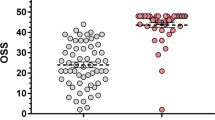Abstract
Frozen shoulder is said to be a self-limiting entity but full recovery often takes more than 2 years. For that, most patients are unwilling to tolerate painful restriction while awaiting resolution. We prospectively investigated 30 patients (16 women, 14 men) for the outcome of arthroscopic capsular release in idiopathic frozen shoulder. Results were determined by the assessment of subjective and objective parameters to estimate both shoulder function and general health status. Symptoms persisted without improvement for a minimum of 6 months of conservative treatment. Preoperative average American shoulder and elbow surgeons score (ASES) was 35, visual analog scale (VAS) to measure pain was 7, and simple shoulder test (SST) was 4. Mean scores of the physical component of SF-36 were considerably reduced. Mean forward elevation was 85°, average abduction was 70°, mean internal rotation was 15°, and mean external rotation was 10°. Patients were followed-up at 6 weeks, 3, 6, 12 months and by a mean of 36 months. Range of motion for all planes improved (P < 0.05). Median VAS reduced to 2, average ASES increased to 91, and SST enhanced to a mean of 10 (P < 0.05). We stated improvement of the physical components in the SF-36 questionnaire in particular bodily pain and the role-physical score. There were no significant differences between the measurements in the early postoperative phase compared to the mid-term follow-up (P > 0.05). Our results demonstrate that arthroscopic release of refractory idiopathic frozen shoulder combined with a gentle manipulation provides reliable expectations for improvement in both clinical and general health status for most patients. We recommend the use of a limb-specific and a general-health-status questionnaire to conclude the benefit of the surgical intervention and contribute the optimization of a therapy concept more effectively.

Similar content being viewed by others
References
Berghs BM, Sole-Molins X, Bunker TD (2004) Arthroscopic release of adhesive capsulitis. J Shoulder Elbow Surg 13:180–185
Bunker TD (1997) Frozen shoulder. In: Norris TR (ed) Orthopaedic knowledge update. Shoulder and elbow, 1st edn. American Academy of Orthopaedic Surgeons, Rosemont, pp 255–263
Gartsman GM, Brinker MR, Khan M, Karahan M (1998) Self-assessment of general health status in patients with five common shoulder conditions. J Shoulder Elbow Surg 7:228–237
Gartsman GM, Khan M, Hammerman SM (1998) Arthroscopic repair of full-thickness tears of the rotator cuff. J Bone Joint Surg Am 80A:832–840
Gerber C, Espinosa N, Perren TG (2001) Arthroscopic treatment of shoulder stiffness. Clin Orthop 390:119–128
Goldberg BA, Scarlat MM, Harryman DT II (1999) Management of the stiff shoulder. J Orthop Sci 4:462–471
Griggs SM, Ahn A, Green A (2005) Idiopathic adhesive capsulitis. J Bone Joint Surg Am 82A:1398–1407
Harryman DT II, Matsen FA III, Sidles JA (1997) Arthroscopic management of refractory shoulder stiffness. Arthroscopy 13:133–147
Harryman DT II, Lazarus M (2004) The stiff shoulder. In: Rockwood CA Jr, Matsen FA III, Wirth MA, Lippitt SB (eds) The shoulder. Saunders, Philadelphia, pp 1121–1172
Ide J, Takagi K (2004) Early and long-term results of arthroscopic treatment for shoulder stiffness. J Shoulder Elbow Surg 13:174–179
Jensen KL, Rockwood CA Jr (2004) X-ray evaluation of shoulder problems. In: Rockwood CA Jr, Matsen FA III, Wirth MA, Lippitt SB (eds) The shoulder. Saunders, Philadelphia, pp 187–222
Jerosch J (2001) 360° arthroscopic capsular release in patients with adhesive capsulitis of the glenohumeral joint—indication, surgical technique, results. Knee Surg Sports Traumatol Arthrosc 9:178–186
Lippitt SB, Harryman DT II, Matsen FA III (1993) In: Matsen FA III, Fu FH, Hawkins RJ (eds) The shoulder: a balance of mobility and stability. American Academy of Orthopaedic Surgeons, Rosemont, pp 501–518
Martin DP, Engelberg R, Agel J, Swiontkowski MF (1997) Comparison of the musculoskeletal function assessment questionnaire with the short form-36, the Western Ontario and McMaster Universities Osteoarthritis Index, and the sickness impact profile health-status measures. J Bone Joint Surg Am 79A:1323–1333
Matsen FA III (1996) Early effectiveness of shoulder arthroplasty for patients who have primary glenohumeral degenerative joint disease. J Bone Joint Surg Am 78A:260–264
McKee MD, Yoo DJ (2005) The effect of surgery for rotator cuff disease on general health status. J Bone Joint Surg Am 82A:971–978
McKee MD, Yoo D, Schemitsch EH (1998) Health status after Ilizarov reconstruction of post-traumatic lower-limb deformity. J Bone Joint Surg Br 80B:360–364
Nicholson GP (2003) Arthroscopic capsular release for stiff shoulders: effect of etiology on outcomes. Arthroscopy 19:40–49
Ogilvie-Harris DJ, Biggs DJ, Fitsialos DP, MacKay M (1995) The resistant frozen shoulder. Manipulation versus arthroscopic release. Clin Orthop 319:238–248
Pearsall AW, Osbahr DC, Speer KP (1999) An arthroscopic technique for treating patients with frozen shoulder. Arthroscopy 15:2–11
Richards RR, An KN, Bigliani LU et al (1994) A standardized method for the assessment of shoulder function. J Shoulder Elbow Surg 3:347–352
Shaffer B, Tibone JE, Kerlan RK (1992) Frozen shoulder. A long-term follow-up. J Bone Joint Surg Am 74A:738–746
Ticker JB, Beim GM, Warner JJP (2000) Recognition and treatment of refractory posterior capsular contracture of the shoulder. Arthroscopy 16:27–34
Ware JE Jr, Sherbourne CD (1992) The MOS 36-item short-form health survey (SF-36). Med Care 30:473–483
Ware JE Jr, Snow K, Kosinski M, Gandek B (1993) SF-36 health survey: manual and interpretation guide. The Health Institute, New England Medical Center, Boston
Warner JJP, Allen A, Marks PH, Wong P (1996) Arthroscopic release for chronic, refractory adhesive capsulitis of the shoulder. J Bone Joint Surg Am 78A:1808–1816
Warner JJP, Allen A, Marks PH, Wong P (1997) Arthroscopic release of postoperative capsular contracture of the shoulder. J Bone Joint Surg Am 79A:1151–1158
Author information
Authors and Affiliations
Corresponding author
Additional information
An erratum to this article is available at http://dx.doi.org/10.1007/s00167-007-0314-z.
Rights and permissions
About this article
Cite this article
Baums, M.H., Spahn, G., Nozaki, M. et al. Functional outcome and general health status in patients after arthroscopic release in adhesive capsulitis. Knee Surg Sports Traumatol Arthrosc 15, 638–644 (2007). https://doi.org/10.1007/s00167-006-0203-x
Received:
Accepted:
Published:
Issue Date:
DOI: https://doi.org/10.1007/s00167-006-0203-x



